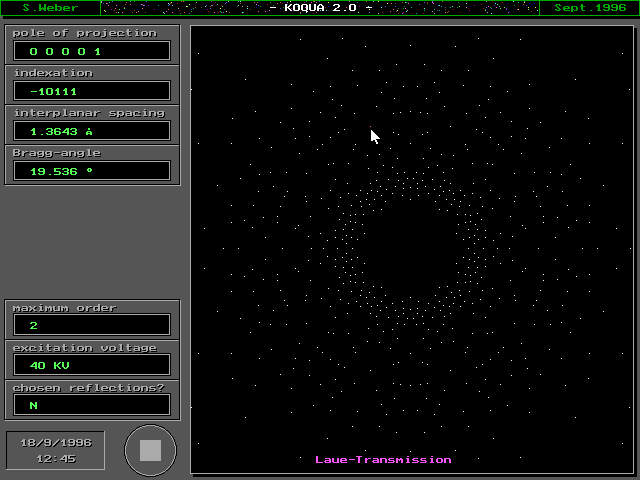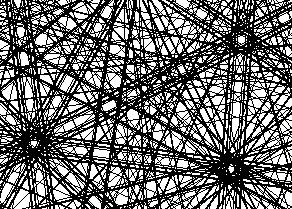|
|
page last modified November 1,1998
This is a program for the simulation of diffraction patterns for the Kossel-technique, where the reflections are recorded on a flat film as a system of Kossel-lines. It can also be used for electron channeling patterns and Kikuchi line patterns. It is applicable to periodic crystals as well as to octagonal, decagonal, dodecagonal and icosahedral quasicrystals. The stereographic projection is used for the simulations instead of the gnomonic projection for the benefit of displaying the whole system of Kossel reflections. Furthermore this allows us to choose any direction of projection by simply clicking the desired pole in the pattern. The program may be downloaded from our FTP-server. You may contact me for questions by email. The package is available in form of a selfextracting archive, which upon execution creates all necessary files in the directory KOQUA22\. The executable file KOQUA22.EXE is compiled for the protected DOS mode (DPMI).
KOQUA can also be used for the following purposes :
The only difference lies in the different wavelength used. For
Kikuchi lines the wavelength might be of the order of 0.1
Angstroem and for the Channeling Pattern of about 0.7 Angstroem
depending on the accelerating voltage. ( wavelength is
approximately 12.4/Voltage[kV] )
In KOQUA2.0 I improved the drawing routines, so it should be possible to to create satisfactory patterns for these two methods, too.
Normal Mode

Example for an icosahdral quasicrystal using a wavelength for
Kikuchi lines (here 0.1 Angstroem).
Laue simulation

Laue transmission pattern for decagonal AlCoNi in
(00001)-orientation, i.e. along the ten-fold axis. No
reflections have been specified. A maximum internal space
component qi=2 is specified to select only the stronger
reflections.
| Kikuchi Simulation | Laue Simulation |
|---|---|
| primitive icosahedral quasicrystal wavelength=0.1 Angstroem with 2-fold, 3-fold and 5-fold pole maximum internal component of wavevectors qint=2 |
face-centered icosahedral quasicrystal
along five-fold axis maximum internal component of wavevectors qint=4 |
 |
 |
You can find the following papers on the application of the Kossel-technique to quasicrystals, where KOQUA was used.
update from November 1998 (KOQUA2.2)
- correct mouse cursor under Windows
- lefthand coordinate system changed to right hand system
- Kossel line select mode implemented
download KOQUA2.2(184Kb)